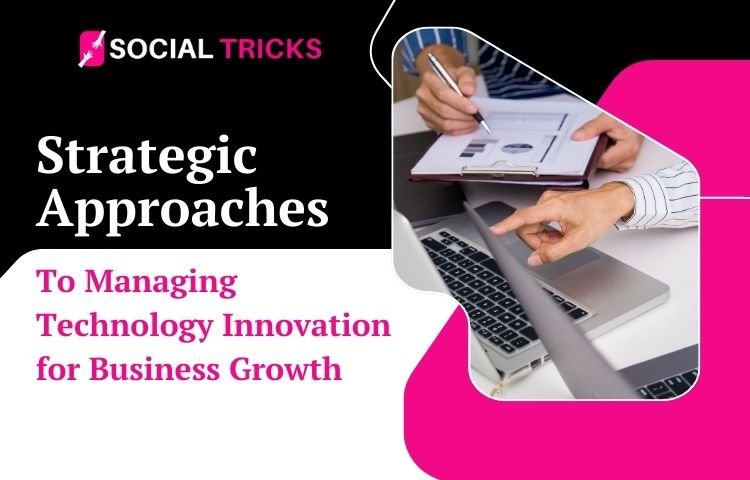In the contemporary world, the effort behind business growth in commerce is technology innovation-generation. It is how these technological ideas are capable of making or growing the mechanics of a concerned company that mostly seems to be maintaining its status quo or chasing after chances elsewhere. With that said, some ways exist for organizations eager to champion technology innovation as an important venue for realizing business growth. Here, we distill the strategic approaches to technology innovation management into some sort of baby language so that even children aged 10 can have an idea of what one is all about in the pop-world!
What Is Technology Innovation?
Technology innovation, in simple language, is the process of creating or improving tools, processes, or systems that can solve a problem or give a better result. These are some examples:
Making new gadgets like smartphones
Augmenting systems that are already in place in some way, such as making apps download faster
Showing how to exploit currently existing technology for new applications
In business, technology fosters smart ways of getting things to work.
Why Does Technology Innovation Matter for Business Growth?
- Greater Efficiency: Automation of tasks saves time and reduces errors.
- Improved Customer Experience: More advanced tools delight customers and generate loyalty.
- Competing for Customers: Riding the technological wave prevents falling behind.
- An Emergence of New Revenue Streams: Technology innovations enable new market niches to be opened and new products sold.
By 2023, businesses that have raised innovation concerns in their organizational tasks have been understood by McKinsey to have grown around 30 percent faster.
Strategic Approaches to Managing Technology Innovation
1. Staying Up To Date with Market Trend
Being in touch with what customers want and what competitors are doing will be key to moving on in business. Companies can:
Conduct surveys
Analyze customer feedback
Use tools like Google Trends to anticipate trends
For instance: A bakery observes that consumers like healthier options; therefore, it innovates by introducing sugarless cakes.
2. Investing in Research and Development (R&D)
An in-house R&D section works on new approaches, which is particularly important for generating innovative ideas. This is the part of the organization for:
Experimenting with new technologies
Testing developmental theories before deciding what to work on
Stat: 93% of companies invest more than 10% of their miles in R&D and leading their own industry (Statista, 2024).
3. Use Collaboration with Experts
Innovation can be much faster when companies join forces with technology experts or other firms. The collaboration may:
Inject fresh perspectives.
Share resources and cut down on costs in the process.
Example: A fashion brand teams with tech firms to innovate in smart clothing integrated with activity tracking technology.
4. Agile
Agility means working in small, faster steps as opposed to much longer, slower processes. Agile methodologies:
Accelerate project development.
Provide a platform for anticipating and adapting to change.
Top Tip: Always break down big projects into small ones, and then assess progress.
5. Going Digital
Digital transformations are about scaling all aspects of a business using digital tools. This incorporates:
Cloud computing for data storage
AI for customer behavior analysis
Automation to cut unnecessary labor overhead
Stat: In 2024, up to 70% of organizations globally shall have a digital transformation strategy (IDC, 2024).
6. Training for Employees
Proper training for employees on new technology initiatives is a helpful tool. To train them, one can:
Conduct more classes from time to time
Enroll employees in online courses
Test and incentivize for different skills enhancement
For example, a customer may position his logistics clients on location awareness GPS tracking, cutting down on delivery delays by 25%.
7. Performance Control and Evaluation
That’s right. Have KPIs now in place to see how innovation is actually working in exploitation. Some of these KPIs are:
Customer satisfaction metrics
Gross revenue
Time saved per task
Learn from mistakes and use results!
Real-World Examples of Success
1. Netflix
Beginning as a provider of DVD rentals, Netflix ventured into streaming early on. And early innovation gave them the following:
-Streaming firmly stood as a leading service.
-They achieved global expansion.
-By 2024, the subscriber base of Netflix had reached 234 million.
2. Tesla
Tesla revolutionized the automobile industry by focusing on electric vehicles (EVs). They achieved growth by:
- Spending on battery technology
- Investing in self-driving configurations
- Creating an EV-charging network
Challenges in Managing Technology Innovation
- Cost: Innovating is an expensive affair, especially when it comes to small businesses.
- Resistance: Verdefables may come in the way of an organization adapting.
- Failure risks: Not everything new will work.
How to Deal with it? Start small, identify or test for wild ideas, and while you ought to proceed slowly taking one step by another line upon line to that big idea of future success.
Trends in Technology Innovation: The Future
Artificial Intelligence (AI): Automating decision-making processes.
Sustainability Tech: Innovations that reduce environmental impact.
Metaverse Development: Creating virtual worlds for business and leisure.
It is very likely that companies that adopt these trends early will be amply thriving in the years ahead.
Final Thoughts
The management of technology innovation is not so much about keeping up with trends as it is about establishing any business purpose for the future. Through the involvement of these strategic approaches like understanding market needs, investing in R&D, and digital transformation have the potential to carry any industry on their wings. Let’s remember to:
Remain flexible.
Track progress, of course.
Invest in people and tools.
Your business will turn its innovative tendencies into impressive results using such strategic approaches.


